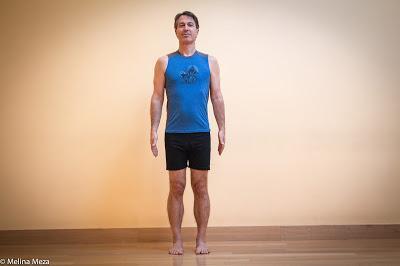
Clear Upward Lengthening of Cervical Spine in Mountain Pose
Q: I'm a 68 year-old female and have recently been diagnosed with cervical radiculopathy. While my yoga instructor is usually very helpful neither she nor the physical therapist I saw can tell me what poses to avoid and which ones can be helpful. My MD is a yoga practitioner and recommends hot yoga. I don't feel that is an option for me. My Dr. is not helpful enough. Pretty much "don't do it if it hurts". So I now am pretty sure what I shouldn't do. It's the poses that are beneficial I need help with. Any suggestions?A: As I reviewed the questions we have received over the years, I found that neck pain is near the top of the list. I have written about neck pain several times in past, and in my post Friday Q&A: Safe Neck Movements, I cover quite a few causes and kinds of neck pain, and make some general recommendations about safe neck stretching and mobilizing movements. However, today’s reader has a slightly different situation going on from what I have previously addressed, as she mentions a diagnosis of cervical radiculopathy. This condition is defined as irritation of nerve roots of the neck due to a herniation or prolapse of a intervertebral disk from its normal position, which impinge or press on nearby nerves resulting in pain and neurologic symptoms. This situation is potentially more serious than some other causes of neck pain and stiffness, as the nerves being pressed on could eventually lead to more permanent nerve damage, resulting in weakness and loss of normal function, especially in one arm. So, if our reader has only seen her family MD about this, my first recommendation is for her to consider seeing a neurologic specialist and getting a second opinion on her condition and cautions for her yoga practice. And although I am always pleased to hear of doctors who are yogis and who consider recommending yoga to their patients as a part of a well rounded therapeutic program for treatment and healing, I personally would not recommend hot yoga in this case, especially for an older adult who might react negatively to the extreme heat of the practice room and because—from my personal experience—the typical hot yoga sequence would not be appropriate someone with our reader’s condition (again, just my opinion hot yoga lovers!) Our reader’s physical therapist and local yoga teacher may have been perfectly justified in being reluctant to offer advice on what to do and what to avoid, due to the greater chance of cervical radiculopathy being a more serious source of neck pain. That said, poses to avoid may be obvious. First of all, avoid any poses where you are bearing weight on your neck and head, including Headstand (Sirsasana), Shoulderstand (Sarvangasana), Plow pose (Halasana), Rabbit pose (Sasangasana), Fish pose (Matsayasana), and so on. Since forward bending of the neck, with or without some rotation, often aggravates or encourages ruptured discs to press on nerves, avoid those movements, too. Examples of forward bending the neck are the chin lock (Jalandara Bandha) and letting your head release to the floor in Downward-Facing Dog pose (Adho Mukha Svanasana). And if you are not certain if the pressure of some unusual pose is safe for your neck, such as the all fours twist with your head on the floor, which is sometimes called Thread the Needle pose (Parsva Balasana) and which Melina Meza calls Reaching Under the Bed pose, then just don’t do it! As for poses or movements that are safe, one generally safe pose to work on is Mountain pose (Tadasana) with a clear upward lengthening of your cervical spine, especially if you have Head Forward Syndrome or Text Neck (see Friday Q&A: Text Neck and Head Forward Syndrome). By actively working this way on a regular basis, you can encourage a healthy, more natural alignment of you cervical bones and discs, which could potentially take some pressure off the impinged nerves that are causing pain, numbness, and tingling that sometime accompany this condition. In other words, work on good posture as often as you can! Other standing poses, such as Arms Overhead pose (Urdva Hastasana), Powerful pose (Utkatasana), Warrior 1 and 2 (Virabradrasana 1 and 2), could also be potentially beneficial, as long as you monitor your symptoms as you work on neutral neck alignment, slight rotation (as in Warrior 2) and slight extension (as in Powerful pose and Warrior 1). Also, you could cautiously try poses that strengthen the back muscles of your neck and those that take your neck into extension or mild back bending shape, such as a low version of Cobra pose (Bujangasana) or Locust pose (Salabasana) practiced dynamically. In summary:
- Get more information about your condition from an expert.
- Avoid obvious poses that aggravate of your symptoms.
- Mindfully try some of the poses where your neck is aligned more neutrally.
- Let your body’s response to the poses guide you to finding poses that support good posture and help you maintain some flexibility and strength in your neck, without creating pain.
DISCLAIMER: This article is not meant to diagnose, treat or act as medical advice. Please consult your health care provider for clearance and guidance before following or participating in these activities.
Subscribe to Yoga for Healthy Aging by Email ° Follow Yoga for Healthy Aging on Facebook ° Join this site with Google Friend Connect

